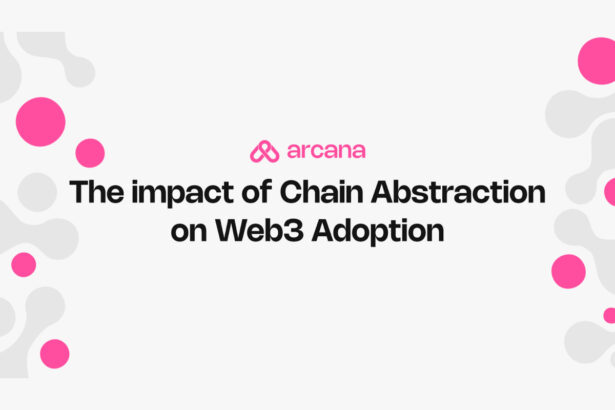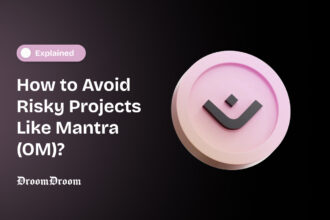For blockchain, UX is essential and therefore its complexity is an Achilles’ heel. A future where hundreds of blockchain networks co-exist, each customized for specific applications isn’t just a possibility – it’s inevitable. This complexity, particularly in user experience (UX), is a significant barrier to mass adoption. The impact of chain abstraction on web3 adoption is critical as UX complexities in blockchain technology present significant challenges.
- Understanding the Impact of Chain Abstraction on Web3 Adoption
- Arcana Network’s Approach
- Key features of Arcana’s Chain Abstraction
- Enhancing User Experience
- Improving Developer Experience
- High Capital Efficiency
- Exactly How Does Arcana’s Modular Layer 1 Works?
- Final Reflections on Impact of Chain Abstraction on Web3 Adoption
Blockchain technology, particularly Ethereum, has made significant strides in scalability with the advent of rollups (Layer 2 solutions). These rollups have drastically reduced transaction costs and increased throughput, making transactions 5-20 times cheaper than Layer 1 and potentially 100-1000 times cheaper in the future. However, these advancements come at the cost of UX challenges. Centralized sequencers in rollups introduce centralization risks and complexities that non-technical users find difficult to grasp.
Users are often required to understand the nuances of different chains and manage assets across them. Just as travelers using platforms like Expedia or Kayak do not need to know which airline’s API is fetching their flight options, crypto users should neither care nor understand which blockchain, rollup, or sidechain —be it Optimism or Base —they are interacting with.
Understanding the Impact of Chain Abstraction on Web3 Adoption
The impact of chain abstraction on web3 adoption is profound and transformative. Chain abstraction is the architectural genius that significantly impacts web3 adoption by allowing users to interact seamlessly across multiple blockchain networks as if they were one chain.
By simply connecting their wallet and signing transactions, users can engage with decentralized apps without worrying about the specifics of underlying chains such as maintaining balances or understanding the distinction between L1 and L2s.
After understanding the initial impact of chain abstraction on web3 adoption, it becomes evident that this technology could transform how users interact with blockchain platforms.
Arcana Network’s Approach
Arcana’s leadership, such as Co-Founder and CEO, Mayur Relekar, have a heavy roster of tech innovation and entrepreneurship, evidenced by his substantial track record of developing scalable Web3 solutions like the disruptive SendIT platform. Under his leadership, Arcana demonstrates how the impact of chain abstraction on web3 adoption can be profound.
“We recognized that the power of blockchain was being hindered by unnecessary complexities and a steep learning curve,” says Mr. Relekar. “Our goal has always been to democratize access to blockchain technology, making it as easy and intuitive as possible for developers everywhere to bring their innovative ideas to life. This is about fostering a more inclusive, innovative future where technology serves everyone, not just the few.”
Mayur Relekar, Co-Founder & CEO, Arcana Network
Arcana Network distinguishes itself with a modular chain abstraction protocol that abstracts away the complexities of multiple blockchains, providing users with a seamless and unified experience.
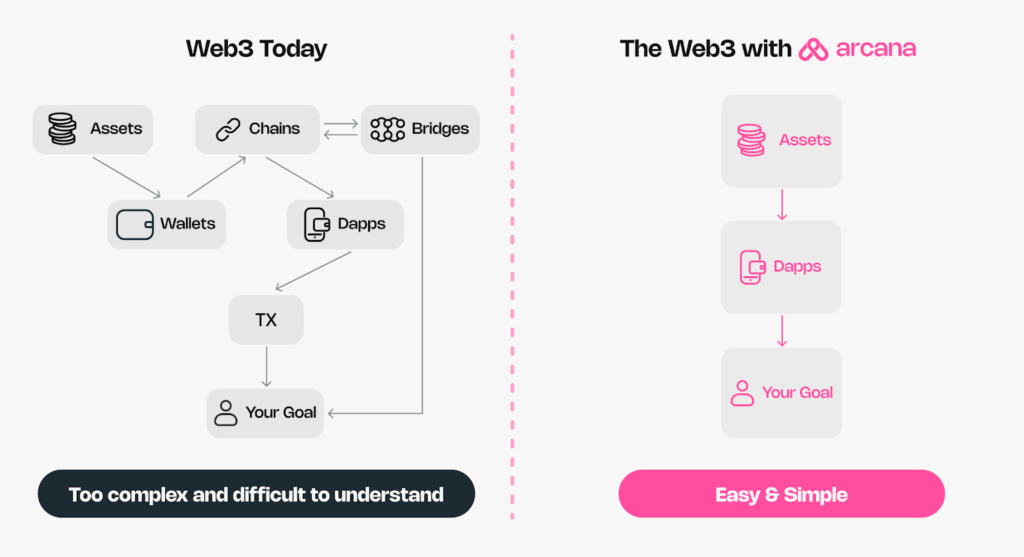
Key features of Arcana’s Chain Abstraction
- Unified User Experience: Aggregates assets across all chains into a single balance, as facilitated by the Arcana Unified Wallet. Works with EOA wallets, Smart Contract Wallets, MPC wallets, and more.
- Universal Gas Token Abstraction: Allows users to perform transactions without needing to hold specific gas tokens for each blockchain, thereby simplifying the process and eliminating the need for manual chain switching.
- Low Footprint Developer Experience: Allows developers to integrate with Arcana once and reach users across multiple chains without needing to maintain separate versions of their applications.
- High Capital Efficiency: Utilizes existing liquidity on the user’s target chain, reducing the need for unnecessary bridging transactions.
- Decentralized From the Ground Up: Arcana’s decentralized MPC Network with Distributed Key Generation (DKG) ensures multiple nodes participate in key management, enhancing security and decentralization.
Arcana Network’s Chain Abstraction protocol, powered by a Modular Layer 1 architecture promises to bring new perspective to blockchain interactions by making them as intuitive and seamless as today’s internet.
Here’s how it achieves this:
Enhancing User Experience
Arcana addresses the challenge of complex multi-chain interactions, illustrating the impact of chain abstraction on web3 adoption, by offering seamless transactions across different blockchains without requiring the user to manually bridge or convert assets.
- Seamless Transactions: Arcana automates the process of transferring and converting assets across different blockchains.
For instance, if you hold ETH on Ethereum and want to interact with a dApp on the Binance Smart Chain, Arcana’s network can automatically manage the necessary conversions and transactions without manual intervention from the user. This means you don’t need to personally handle the bridging of ETH, its conversion to a wrapped version on BSC, or swapping it for BNB.
- Unified Interface: By presenting a unified balance, Arcana provides a consolidated view of a user’s assets across different chains. This feature further reinforces the impact of chain abstraction on web3 adoption by eliminating the need to switch between multiple wallets or interfaces to manage assets on different blockchains by eliminating the need to switch between multiple wallets or interfaces to manage assets on different blockchains.
For instance, users can operate as if all their assets were on a single platform, simplifying interactions like purchasing an NFT on Polygon with ETH originally held on Ethereum.
Improving Developer Experience
Developers often face challenges related to operating across multiple blockchain networks, each with its distinct user base and liquidity pools.
Let’s take Aave protocol for example, which wants to offer its lending and borrowing services across Ethereum, Polygon and Avalanche. Each of these blockchains operates as a separate state machine.
This means that for Aave, operating across these platforms necessitates the deployment and ongoing maintenance of smart contracts that are specifically tailored to each chain’s unique protocols and standards.
Moreover, Aave has to ensure that liquidity pools are adequately funded on each network which demands extensive resources and coordination.
Arcana Network addresses these issues by providing:
- Single Integration Point: Developers can integrate with Arcana once and support multiple chains, eliminating the need to develop and maintain separate versions of their applications for each blockchain.
This simplification directly stems from the impact of chain abstraction on web3 adoption, enhancing high capital efficiency and reducing development overhead.
High Capital Efficiency
When traders move assets like USDC from Ethereum to Solana for various requirements, they typically use cross-chain bridges such as Wormhole. This process involves locking USDC on Ethereum, minting wrapped USDC on Solana, and incurring transaction fees in both ETH and SOL. The bridging process is not only costly and time-consuming but also reduces arbitrage profitability by locking substantial liquidity in bridging contracts.
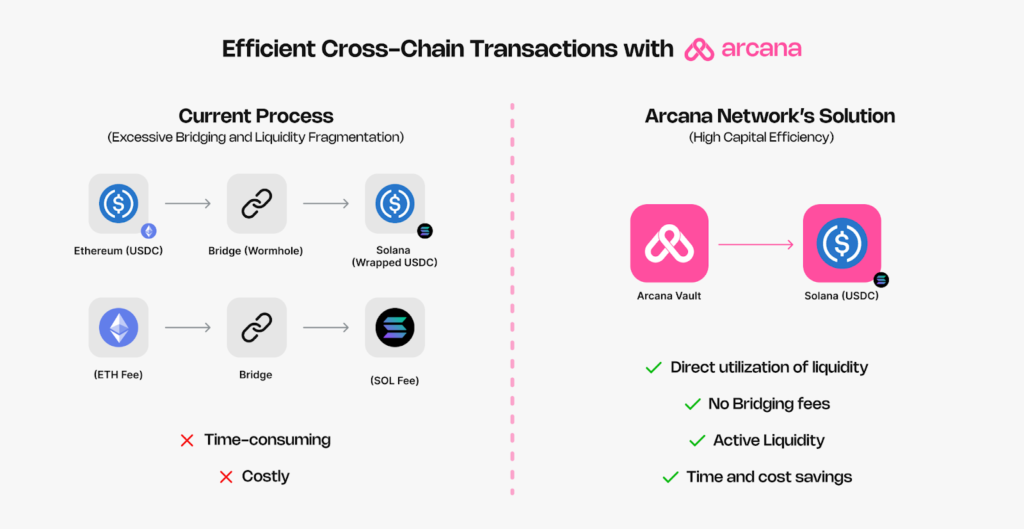
Arcana Network offers a more efficient alternative. Instead of the conventional bridging process that locks USDC on Ethereum and mints a wrapped version on Solana, Arcana utilizes a liquidity pool (referred to as the “Arcana Vault”). This vault holds the necessary liquidity and executes transactions across blockchains based on the network’s instructions, thereby:
- Direct Utilization of Liquidity: Arcana directly utilizes the liquidity available on chains like Solana, saving time and reducing the multiple transaction fees typically incurred in cross-chain transfers.
- Netting and Rebalancing: Arcana’s network actively tracks and nets user spends across various chains, issuing rebalancing instructions to liquidity providers as necessary. This ensures that funds are not unnecessarily locked in bridging contracts but are actively employed where they are most needed, enhancing liquidity efficiency and reducing overhead costs.
However, users do not have to purely rely on the Arcana Vault to fulfill user intents, independent solver/filler network works alongside the vault.
Exactly How Does Arcana’s Modular Layer 1 Works?
The bedrock supporting Arcana’s ambitious vision is a decentralized network of nodes.
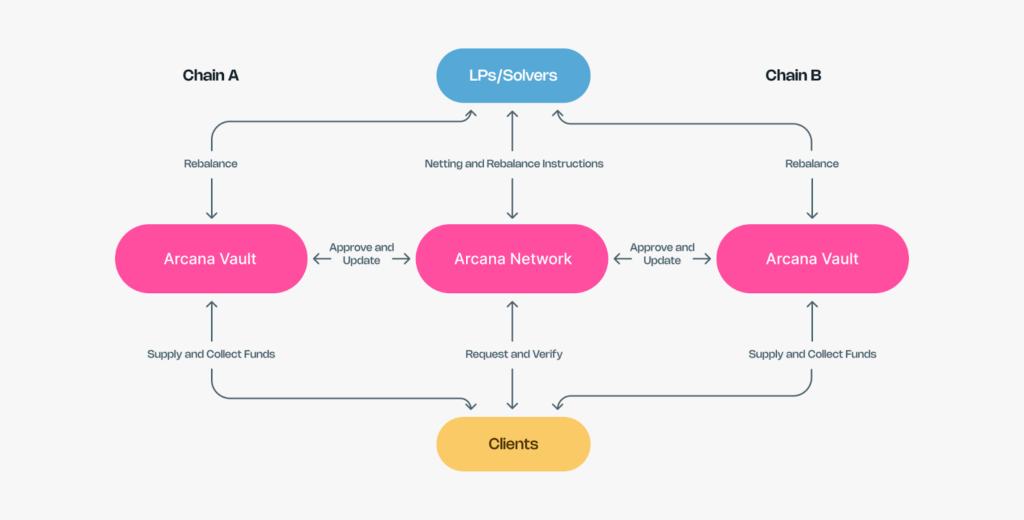
Here’s how each component of this infrastructure contributes to chain abstraction:
- Clients are the end-users that initiate requests, clients interact with the Arcana Network to perform various operations such as transferring funds or executing transactions.
- Arcana Network is the central component that receives requests from clients, verifies these requests and coordinates the necessary actions. It uses a netting mechanism to optimize liquidity. It tracks spending and collections across various chains and issues rebalancing instructions to liquidity providers.
- Arcana Vaults, deployed on different blockchains (Chain A and Chain B), manage the actual supply and collection of funds. They hold the liquidity required for transactions and execute operations based on instructions from the Arcana Network.
- LPs/Solvers are third-party liquidity providers, competing to provide liquidity, ensuring competitive rates and efficient fund allocation for the purpose of maintaining optimal capital efficiency.
Final Reflections on Impact of Chain Abstraction on Web3 Adoption
If we look back at how the internet has changed over time, we can get a hint about where it might be going next. The crypto industry is moving into an era of chain abstraction, where blockchains and other infrastructure will become increasingly invisible to users and to an extent developers.
For users and developers alike, the impact of chain abstraction on web3 adoption will lead to more flexibility. Similarly, removing the burden of these choices from users lets the open web start to feel more like today’s internet.
Arcana Network’s modular chain abstraction protocol exemplifies this transformation. It provides a new programmable environment for building apps that seamlessly span across blockchains and keep the blockchain details hidden from users – representing a powerful new paradigm to usher in a new era of smoother user experiences better than what’s available on Web2.
